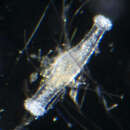en
names in breadcrumbs


Craspedacusta sowerbyi possess cnidocytes with nematocysts, otherwise known as stinging cells. Unlike some other jellyfish, the nematocysts of freshwater jellyfish are unable to penetrate human skin (Peard 2000). Therefore, freshwater jellyfish are unable to produce the painful sting caused by most marine jellyfish.
Freshwater jellyfish are hard to raise in an aquarium. If you choose to try raising one, here are some things to keep in mind: 1) make sure that you have a filtration system that will not suck up the jellyfish (sponge filters are not recommended); 2) do not use a tank that has a strong current; 3) jellyfish can kill small fish with their stinging cells; 4) jellyfish require a constant supply of food (brine shrimp or Daphnia are suggested) (Peard 2000).
Information about Craspedacusta sowerbyi is incomplete. Researchers continue to study this organism. Indiana University of Pennsylvania is currently involved in an in-depth study of this creature (Peard 2000).
Freshwater jellyfish are unpredictable in their appearance within bodies of water. They may appear in large numbers one year, not appear the next, and come back several years later (Peard 2000). Thus, populations are difficult to predict.
Despite this unpredictability, conservation within the United States, and around the world, does not appear to be an issue. Craspedacusta sowerbyi remain the most populated jellyfish in the United States (Davis 1998).
US Federal List: no special status
CITES: no special status
The diet of the freshwater jellyfish consists primarily of zooplankton, which range in size from 0.2 to 2.0 mm in size. It uses its nematocysts located on tentacles to sting and paralyze prey before scooping it into its mouth (Pennak, 1989).
Craspedacusta sowerbyi is a freshwater jellyfish occupying all continents, . It was first taxonomically recorded in England, in 1880. The United States did not report Craspedacusta sowerbyi until 1908. As of February 8, 2000, this organism was reported in 43 out of 50 states. With increased interstate and intercontinental travel, the translocation of Craspedacusta sowerbyi into new habitats continues (Davis 1998).
Biogeographic Regions: nearctic ; palearctic ; oriental ; ethiopian ; neotropical ; australian
Craspedacusta sowerbyi has been found in a variety of freshwater environments: freshwater lakes, reservoirs, man-made impoundments, water-filled gravel pits, rock quarries, algae-filled ponds, and rivers. Craspedacusta sowerbyi seems to favor calm water (Pennak 1989, Peard 2000).
Habitat Regions: temperate ; tropical ; freshwater
Aquatic Biomes: lakes and ponds; rivers and streams
This organism shares many of the same traits characteristic of most jellyfish. It is a white or green gelatinous creature, with 99% of its body made of water (Peard, 2000). This organism lacks a head, a skeleton, contains no special organs for respiration or excretion (Davis, 1998).
The freshwater jellyfish is dimorphic, alternating between both a polyp and medusa morph (Johnson and Raven, 1999). The mature medusa stage resembles a bell shape. It also contains the manubrium, four radial canals, and one circular canal, typical of most jellyfish.
The diameter of the circular canal is anywhere from 5 to 22mm. It bears string-like tentacles, arranged in sets of three to seven. The tentacles are solid and vary in length. Tentacles, with nematocysts, aid in capturing food and serve as a type of protection against predation. At the base of their tentacles, jellyfish have eyespots. These are used in detecting light and dark, providing another means by which to find food and escape predation.
This organism can move in any direction by pulsating contractions along its bell surface. The bell margin is made up of statocysts while the velum is made of nematocysts, which are in abundance around the mouth. This is helpful when the jellyfish is killing its prey, helping to draw the prey into the jellyfish's mouth (Pennak 1989).
Range mass: 3 to 5 g.
Other Physical Features: ectothermic ; heterothermic ; radial symmetry ; venomous
Craspedacusta sowerbyi reproduce asexually in the polyp form, via budding. They can form three different types of buds: polyps, frustules, or medusa buds. The polyp bud grows and develops while still attached to the original polyp. The frustule bud develops into a frustule; they are only able to travel a short distance before developing into a new polyp. The medusa bud detaches to form a free-living adult medusa, which reproduces sexually via fertilized eggs, which develop into planula larva. These larva settle onto underwater surfaces (plant roots, rocks, and tree roots) where they develop into polyps (Peard 2000).
Sexual reproduction is relatively rare in this form of jellyfish. Most populations are strictly male or female (Peard, 2000).
Scientists are still learning about the larvae and the conditions affecting the dispersal of this organism. Correlation studies have demonstrated a relationship between increased travel distance of the larvae and increased polyp feeding. It is believed that increased polyp feeding increases the energy stores of the frustules, allowing them to travel greater distances (Peard 2000).
The polyps can be distributed passively as well. During winter months, polyps contract and become dormant, as to survive the cold temperatures. These polyps, also known as podocysts, can be transported by aquatic plants, aquatic animals, or birds' feet to new areas of dispersal. As winter ends, and conditions become more favorable, the podocysts transform into polyps (Peard 2000).
Key Reproductive Features: iteroparous ; seasonal breeding ; gonochoric/gonochoristic/dioecious (sexes separate); sexual ; asexual ; broadcast (group) spawning; oviparous
Parental Investment: no parental involvement